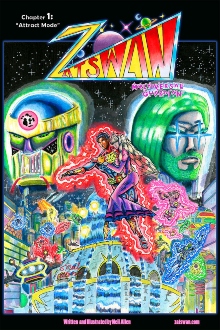About John Stewart
on July 1, 2013
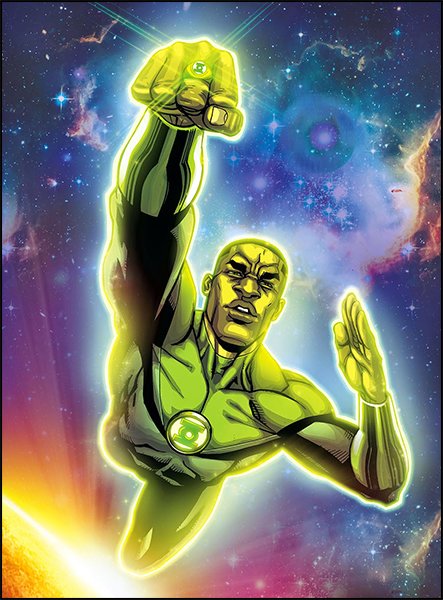
There are a number of reasons why I made this website. First and foremost is that Green Lantern John Stewart is my favorite comic book character and I want a place where fans can celebrate him.
Second is that his role in Van Jensen, Marcelo Maiolo, and Bernard Chang’s Green Lantern Corps excited me and I wanted a place to channel that excitement. Seeing Green Lantern John Stewart shine so brightly motivated me to construct this site to support him and show appreciation for the character.
Also, upon hearing the rumors that DC Comics had plans to kill the character in 2013, I was deeply bothered. For so long, John Stewart was treated incredibly poorly. Despite having strong visibility and a passionate fanbase, due to appearing on the milestone Justice League and Justice League Unlimited cartoons for five years, John was pushed out of sight in the comic books, while other versions of Green Lantern stepped to the fore. This didn’t make any sense to me, and it was greatly frustrating. One would think the comic creators would want take to advantage of John Stewart’s audience and capitalize on it, but the exact opposite was done. Feeling rather alienated, I eventually got fed up and stopped buying Green Lantern comics.
Years of marginalizing John Stewart apparently wasn’t enough. When Geoff Johns, who was Chief Creative Officer at DC by this time, was getting ready to release direct control of the Green Lantern franchise, mysterious things began happening. Joshua Hale Fialkov, upcoming writer of the titles Green Lantern Corps and Red Lanterns hastily dropped both projects before a single issue of his shipped, citing “creative differences” as the cause. Multiple large comic book websites began reporting that the reason for Fialkov’s leaving involved an editorial mandate to kill John Stewart.
When the news leaked a massive backlash swept across the internet. That was the last straw for many people. Perhaps certain officials at DC thought that after they intentionally sidelined John for so long that no one would care about him.
If that’s so, they were very wrong. Scores and scores of people stood up for Green Lantern John Stewart, proclaiming how great of a character he is, and the impact he has had on many people, and how important he is for being DC Comics’ first African American superhero. Because of this large movement, the plans to kill John Stewart were reportedly nixed. Fialkov later came out and verified the rumors as true. A new writer named Van Jensen was placed on Green Lantern Corps, and told one of the greatest John Stewart stories yet.
 |
|
Green Lantern John Stewart. An Earth man chosen by the Guardians of the Universe to join the Green Lantern Corps – an intergalactic peace keeping force dedicated to preserving life throughout the universe. |
This shows that we can and do make a difference! That is why this site is here. It is another exhibition of support for the character of Green Lantern John Stewart, to show that no matter what his opposition tries to do, John Stewart will always have passionate fans. No matter how far they try to stick him in the background, or how much some would like to get rid of him, or how much they try to force another Green Lantern on us, they will never erase what John Stewart means to us, and we will always be here willing to speak up on his behalf.
But why are we so invested in this character?
John Stewart is introspective, yet outspoken. He’s sensitive, yet very strong. He’s intelligent and philosophical. Pragmatic, yet always dreaming of better ways to build things. Seeing him among all the weird and wonderful aliens that are his Green Lantern Corps mates has a big effect, because, at first glance, he seems so regular. He does not have a glamorous day job, he’s not cut from the same cloth as Silver Age super heroes, and his personality, though deep, is not boisterous and far out. He’s a regular guy given great powers and interacting with alien surroundings. He also sends the incredibly positive message that a non-White person can be selected to represent humanity as its best and brightest, which speaks volumes.
It is only right to honor a character that is not only a fascinating personality in the DC Universe, but also such a cultural breakthrough and positive inspiration to many, many people.
Let’s take a look at who Green Lantern John Stewart is.
Introduced in 1971 by writer Denny O’Neil and artist Neal Adams, John was created when DC Comics sought an alternate for then Green Lantern, Hal Jordan. Neal Adams realized that it wouldn’t make sense to have another White male as Green Lantern. Green Lanterns are space police administrated by the Guardians of the Universe who reside on the planet Oa. The Lanterns are chosen for their integrity and ability at overcoming fear. Neal Adams’ reasoning was that looking at an event like the Olympics, one could see a myriad of people from many races representing the cream of the crop in their given areas of expertise. Therefore, continually depicting White men as being the best was a very narrow, biased, and unrealistic view.
Neal made some headway with that notion, but ran into another difficulty from DC Comics editor in chief, Julius Shwartz. Julius had agreed with Neal, but decided to name the character Lincoln Washington, which Neal immediately knew would not be a good idea. Neal convinced Julius that Lincoln Washington was a “slave name,” and Neal dubbed the character John Stewart.
 |
|
John Stewart during his 1971 debut. |
John made his splash in a racially charged story in the blaxploitation rife ‘70s. He appeared as a young architect who was out of work because of the color of his skin. The Guardians of the Universe deemed him worthy of joining their intergalactic peace keeping force, the Green Lantern Corps. In the event that Earth’s Green Lantern, Hal Jordan, wouldn’t be able to fulfill his duties, John would assume the role. John was granted a power ring, which gave him a myriad of abilities, such as creating solid light constructs of whatever he could imagine, given he had enough will power to form them, flight, a protective aura that provides defense and comfortable atmosphere that shields him from hazardous environments, and translation of nearly all languages. He fulfilled his duties ably and left the spotlight as Hal Jordan and partner, Green Arrow, continued their quest to find America and confront social and political issues in the Green Lantern/Green Arrow series.
Over the years, John would appear sporadically when Hal couldn’t for whatever reason. His life was fairly normal, except the rare times when it would get very strange and he would become a superhero for a short while. He was quite a relatable character in that he seemed to exist somewhat outside of the story; he wasn’t caught up in the bizarreness of the whole super hero affair and would realize how strange or corny things were. A character like Hal Jordan could never see things from that perspective because he was inundated in that strangeness and corniness and was part of it himself.
John Stewart’s big break happened in the 1980s. He became the marquee Green Lantern when Hal Jordan decided to give up his ring. According to then writer, Steve Englehart, sales of the Green Lantern comic doubled while John was the main character. During this crucial period in the character’s life, he would secure his identity as “The Green Lantern” and also forge a romantic attachment with Katma Tui, who was John Stewart’s first notable love interest. A fellow Green Lantern from the distant world of Korugar, Katma was assigned to train John in the use of a power ring and the protocol of a Green Lantern. The duo went on many adventures that took them around the Los Angeles area all the way to the expanses of outer space. John also played a crucial role as Earth’s Green Lantern in the landmark Crisis on Infinite Earths crossover at this time.
Later on during the ’80s, the Green Lantern comic book became a team book and was renamed The Green Lantern Corps. John shared this book with several other Green Lanterns, including Katma, who he eventually married. This setup continued until the comic’s cancellation in 1988. According to Steve Englehart, Green Lantern Corps was so popular that DC used it to try and get their Action Comics Weekly comic going steadily. However, the difference in setup wasn’t to Englehart’s liking, and he and artist Joe Staton left the Green Lantern project and John Stewart. Both contributed greatly in establishing John as a credible leading super hero in his own right.
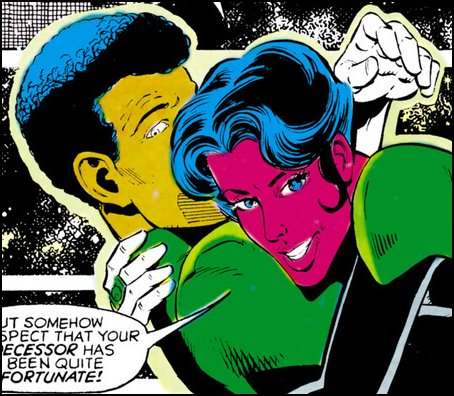 |
|
John Stewart as the primary Green Lantern in the ’80s, with his love interest, Katma Tui – the Green Lantern of planet Korugar. |
During this strange period of Green Lantern, when there was no definite Lantern comic book, and the stories were relegated to being features in Action Comics Weekly, John Stewart lost his powers and regained them, and Katma Tui was unceremoniously killed off; murdered by long time Green Lantern villain Star Sapphire in a throw away story. Tastes within the industry and market changed to take on a grittier tone, and Katma’s death was but the first in a chain of events that sent John down a long, dark, downward spiral.
In one especially awkward tale, John was accused of a crime Hal Jordan committed, and framed by Star Sapphire for the death of her alter-ego, Carol Ferris. John found himself in South Africa, where he was detained, stripped naked, and whipped because he refused to sign a paper the police wanted him to that would have him admit to crimes he did not commit. I’m not sure what the deal was with the writing at this point, but it seems all the writers could do was make John’s life a living hell in various ridiculous ways.
Sadly, it gets even worse.
In the 1988 story Cosmic Odyssey, in a bout of uncharacteristic arrogance (read: poor writing), John Stewart failed to save planet Xanshi and all its inhabitants died. Racked with guilt, and being subject to an intense browbeating from fellow hero, Martian Manhunter, John Stewart contemplated suicide. Ultimately, he decided to live with the terrible mistake he had made.
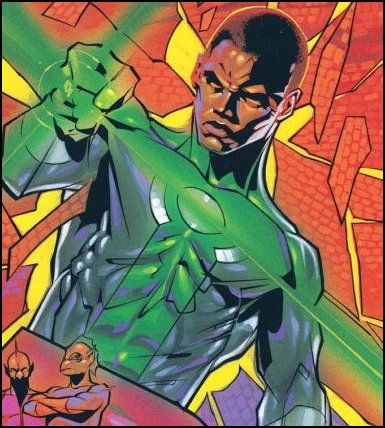 |
|
Art from John’s highly acclaimed and thought provoking series, Green Lantern: Mosaic. |
Despite suffering continued torment and bad writing, there was a light at the end of the tunnel during the turn of a new decade. In the early ’90s John embarked on one of his most fascinating adventures. A Guardian of the Universe who had been driven insane by loneliness uprooted cities from all the worlds he visited and placed them on Oa so their inhabitants could keep him company. The mad Guardian was defeated, but the cities remained. The other Guardians elected that John Stewart be the Green Lantern of this Mosaic World and keep the peace among all the disparate races while the Guardians gathered enough energy to send the cities back home.
The series Green Lantern: Mosaic was launched, which chronicled John’s adventures on Oa. It featured a guilt ridden John Stewart trying to come to terms with the hardships that he had undergone. It was a brilliant story, far more cerebral and philosophical than any Green Lantern story before it. Far removed from the usual super hero fare, instead of flashy hero/villain battles, the book focused on John Stewart building a cohesive society by cleverly solving problems, all while wrestling with his emotional and psychological phantoms. He was aided by Rose Hardin, a West Virginia farmer who became his love interest and confidante.
Though Green Lantern: Mosaic was a great success, DC cancelled the series after 18 issues because it did not meet the executive vision. Writer Gerard Jones was forced to hastily wrap up his series, but he managed it gracefully. The series concluded with John Stewart successfully uniting the people of the Mosaic World and becoming the first mortal Guardian of the Universe, with the moniker of “The Master Builder.” For all he had done, he was rewarded with the resurrection of his deceased wife, Katma Tui, and the two were reunited at long last.
During the mid ’90s, there was a scorched earth campaign in Green Lantern when the character Kyle Rayner was introduced. The Green Lantern franchise was abruptly turned on its head with the death of the Guardians of the Universe and the destruction of the Green Lantern Corps. John Stewart’s Guardian powers, Green Lantern powers, and newly resurrected wife were taken from him, and the Mosaic was broken apart.
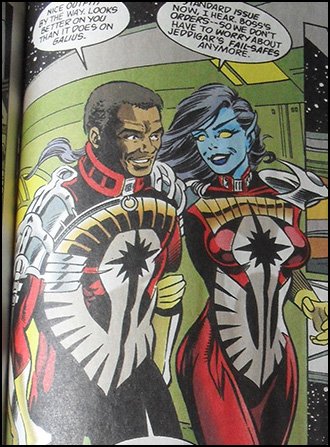 |
|
John Stewart as a Darkstar, with Merayn Dethalis, in the service of the Controllers. After Mosaic ended, John appeared in The Darkstars series. |
Soon after those events, John was approached by the Controllers; relatives of the Guardians of the Universe who branched off and left them due to a difference in ideology over how to best care for the universe. With the Guardians gone, John chose to serve the Controllers and became the leader of the Darkstars, the organization of universal peace keepers loyal to the Controllers.
As the ’90s pressed on, removing John Stewart from being Green Lantern wasn’t good enough, the writers and/or editors also saw fit to break his back, thus paralyzing him from the waist down. His ability to walk was eventually restored, but only to have it taken right back away from him, sending him back to the wheelchair from whence he came.
In 2001, the Justice League animated series by producer Bruce Timm hit airwaves, and things began to change drastically for our Green Lantern. The series united Earth’s greatest superheroes into a team to fight evil. John Stewart was chosen as the Green Lantern for this show, and stood beside such luminaries as Superman, Batman, Wonder Woman, and The Flash. It was a choice due partially to race, with every other member of the team besides the alien Martian Manhunter being White. Besides that, though, Bruce Timm and his team genuinely liked John and wanted to use him. John Stewart surprised audiences by being the show’s real breakout star rather than being a simple token. The developers took great care in sincerely building the character and fleshing him out, showcasing him as the center of many stories and giving him a complex personality with several fun touches. Since expectations for John weren’t as high as they were for, say, Superman, the developers had a lot of freedom to do what they wanted with Green Lantern, and it worked out incredibly well.
John Stewart was an ex-Marine who joined the Green Lantern Corps. Leaving Earth behind, he trained under the veteran Green Lantern Katma Tui, and proved himself an exceptional champion time after time as he soared across the cosmos. When Abin Sur died, John was chosen to be the Green Lantern of Space Sector 2814, which includes planet Earth. John returned home, but reeled from the huge culture shock from having been out in deep space so long. While there were many new elements added to the character, he was still John Stewart at heart, displaying the same strengths and even insecurities that the ever evolving character in the comics continuity displayed. One of the most notable aspects of the character was his complex love story with fellow leaguer Hawkgirl. John continued to have a huge role in Justice League‘s 2004 sequel, Justice League Unlimited, which featured a greatly expanded Justice League roster, and continued to explore Green Lantern’s romance with Hawkgirl. Highlighting an interracial relationship as much as the Justice League cartoons did, and in such a deep way was a true milestone for western animation.
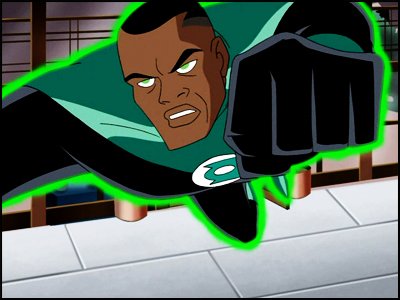 |
|
Green Lantern in Justice League, the wildly popular and influential cartoon produced by Bruce Timm. |
Since John was such a success on television, the comic book editors and writers decided to bring him out of inactivity by restoring the use of his limbs AGAIN. After overcoming his crippling condition, he was given a power ring by Kyle Rayner and made the Green Lantern of Earth while Kyle went on a space escapade. That might sound like an important role, but John Stewart didn’t do much. He joined the Justice League of America and went on some rather unremarkable adventures that didn’t do anything to advance his character. The cartoon show was making great advances with the character, and the way was already paved for the comic writers to capitalize on that, but they barely utilized him for anything notable.
John would keep doing fairly unremarkable things for many years to come. The Green Lantern Corps and the Guardians of the Universe were brought back, which sounds very exciting, but John Stewart was pushed to the background even more, for whatever reason. When the Justice League show stopped airing new episodes, not much was being done with the character in any realm, comics or television. He was once again granted a spot in the Justice League of America comic book, but that was quickly taken away from him. He floundered in comic limbo until he was granted a co-starring role on Green Lantern Corps alongside Kyle Rayner, and then with Guy Gardner when DC rebooted their continuity with the New 52 in 2011. This was an improvement, but again, his adventures were unremarkable and he was often playing second fiddle to Guy Gardner. I followed these adventures to support John, but they didn’t make much of an impression on me, as it seemed like the writers had him there just to do something with him, but they didn’t display a genuine interest in him.
Since DC was gearing up to kill John Stewart around this time, they could have been intentionally marginalizing him to make it so readers would not be invested in him, which would help minimize backlash against the death. With the incredible failure of the 2011 Green Lantern film headlined by Hal Jordan, DC could have been desperate to get rid of John Stewart out of fear that Warner Bros.–DC’s parent company–would opt to use John Stewart in future films. As noted above, writer Joshua Hale Fialkov refused to write John Stewart’s death, and the whole debacle went public causing huge outcry. Due to the uproar, DC changed plans and made John Stewart the star of Green Lantern Corps.
 |
|
John Stewart soaring in his New 52 title, Green Lantern Corps. |
Van Jensen was hired to write Green Lantern Corps in 2013, and with artist Bernard Chang, and Colorist Marcelo Maiolo, he took John Stewart to new heights, showcasing him as the confident, competent, and complex hero millions loved from the Justice League cartoon show. However, Jensen did not coddle John. The writer viciously ended John’s relationship with enemy turned girlfriend Fatality with the shocking reveal that she was brainwashed by the Star Sapphires into loving him. When the brainwashing effects wore off, Fatality–the sole survivor of Xanshi–went back to ruthlessly hating the Green Lantern for failing to save her world. Furthermore, John discovered that for much of the time he thought he was with Fatality, he was actually with a shape shifting spy of the Durlan race who abducted Fatality and took her place. The Durlans bore an ancient grudge against the Green Lantern Corps, and instigated a universal uprising to oust them from power.
John and the Corps defeated the Durlans, but knowing he was intimate with a shape shifting enemy, and that Fatality hated him in truth, and that he couldn’t tell the difference between the woman he thought he loved and a shape shifter left him emotionally, mentally, and physically drained. Yet, still he fought on when the New Gods–vastly powerful beings from beyond the multiverse–violently invaded his universe in search of the precious Life Equation during the “Godhead” event. In midst of this cosmic war, John Stewart became the first male member of the Star Sapphires, which is a position he accepted out of necessity, as he was not proud of wearing the Star Sapphires’ ring due to them compelling Fatality to love him against her will. However, the violet ring’s power proved invaluable when John used it to save the planet Zarox from suffering the same fate as Xanshi.
Jensen’s character driven writing and the absolutely stunning visuals from Bernard Chang and Marcelo Maiolo rejuvenated my interest in Green Lantern comic books. Furthermore, Van Jensen updated John’s rather dated origin for the New 52 in the Secret Origins series. Jensen incorporated the best elements of John Stewart from the comics and cartoons, highlighting both his Marine and architect backgrounds. He also made John’s origin completely independent of Hal Jordan. No longer was John a “backup,” but an important figure of prophecy who the Guardians had been watching all his life.
The Van Jensen, Bernard Chang, and Marcelo Maiolo Green Lantern Corps run was followed by Green Lantern: Lost Army by writer Cullen Bunn and artist Jesus Saiz. This story features John Stewart leading a team of Green Lanterns after they all mysteriously woke up in an unfamiliar universe with no apparent means of recharging their power rings. They are accompanied by Krona, an Oan scientist obsessed with the unknown who attempted to view the beginning of the universe billions of years ago, despite it being forbidden by Oan guidelines. And this is where we are today!
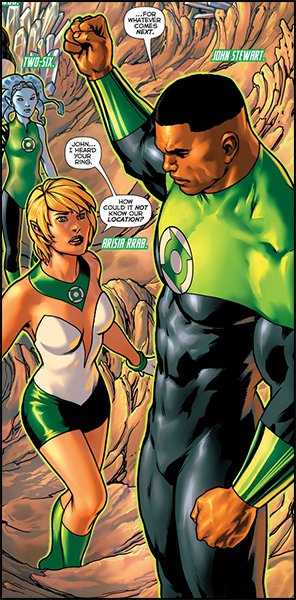 |
|
John Stewart in his current title, Green Lantern: Lost Army. |
It’s great to see DC is giving John Stewart honest efforts with spectacular creative teams after years of sidelining. I like the results so much that they inspired me to create this web site. I hope with John Stewart’s treatment in comic books, along with the help of this site, many can come to see what is so great about this particular Green Lantern who some of us have followed for years and years.
I was introduced to the character through the animated Justice League series. He really interested me because of how well written he was. His strong characterization drew me in and I was easily able to get invested in the character. I don’t really like John Stewart just because he’s Black, but I’ll be frank, it was honestly surprising to see a non-White get the amount of focus he did, especially standing beside the likes of Superman and Batman. It was also cool how his being Black didn’t matter, in a manner of speaking. The show never ignored the fact that he was Black, but it wasn’t a big part of his character. He just happened to be that way, just like how many of the others happened to be White. It was very gracefully handled.
His television appearances inspired me to look him up in comic books and I found more to like about the character. I like that Green Lantern is all John Stewart is. He doesn’t even try to maintain a double life and I believe this is to the character’s benefit. Many of Hal Jordan’s tales are awkward because the stories try to juggle him being a space policeman with him working a job and having a social life on Earth. Because superheroes just have to have secret identities and live normal lives on the side, right? That just does not work very comfortably for Green Lantern, because the Earthbound stories don’t mix all that well with the cosmic ones. One aspect is always being neglected for the other and they both wind up being watered down and undeveloped. After a certain point, John Stewart no longer attempts to maintain a normal life on Earth, and that works out a lot more solidly.
Also, I have not seen too many characters get dragged through the mud as much as Green Lantern John Stewart has. As absurd as it sounds, there have been times when it seemed that DC Comics did not want the character to succeed, but despite all of this, John Stewart goes on being a popular and successful character. This is one of the things that draws me to him and makes me root for him. Green Lantern readers will know that Hal Jordan also went through tough times, but he basically got a “get out of jail free” card that explained all of his troubles away with convoluted retcons. John Stewart gets no such luxury, and I’m actually happy that he doesn’t. The fact that John Stewart keeps getting back up, keeps succeeding, even when it seems the creators are against him, is a testament to him as an enduring, influential, and great character.
No other character in the Green Lantern franchise shows nearly as much strength. No other character in the franchise is nearly as culturally influential as this dark skinned Green Lantern. No other is nearly as versatile, complex, fascinating, multi-layered, or inspirational.
These are reasons why Green Lantern John Stewart fans are drawn to him, why he makes such a difference to us, why his adventures will always mean something to us, and why we’ll always be here willing to stand up for him. He is a truly important character and accomplishment.














